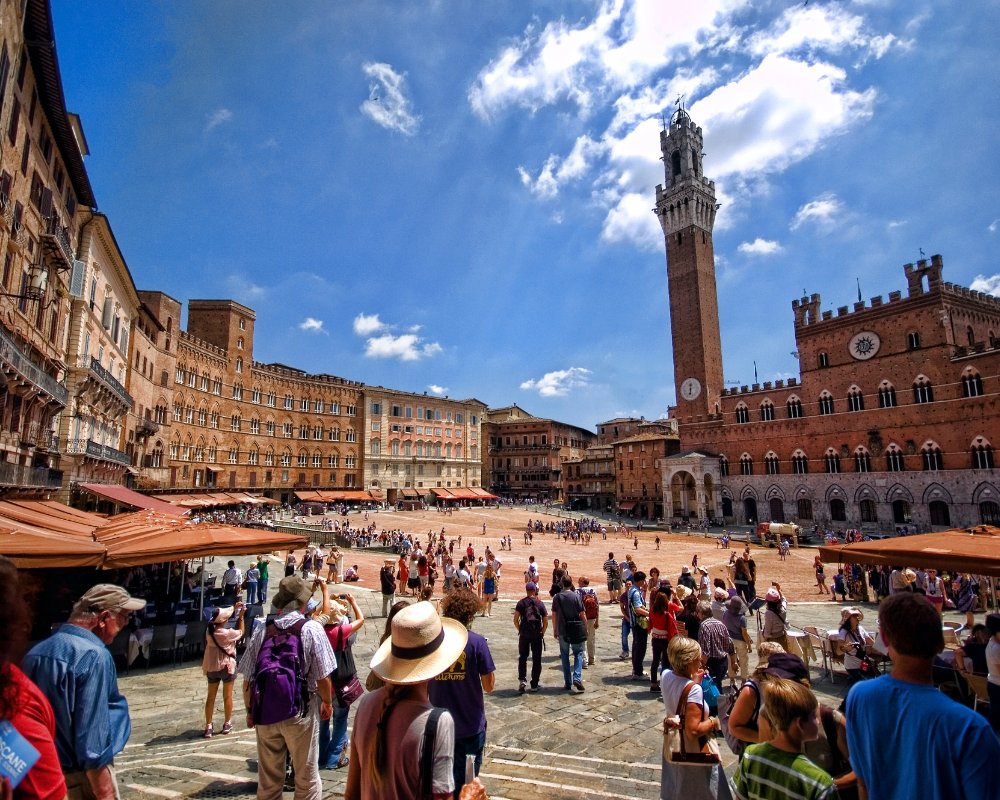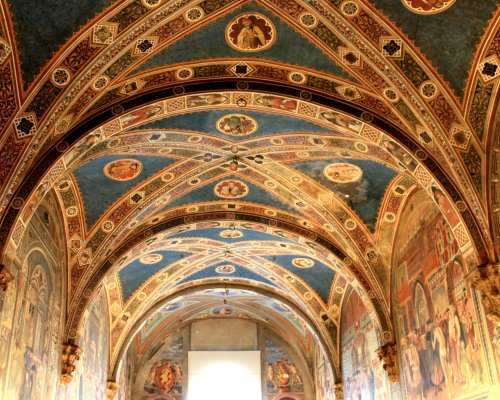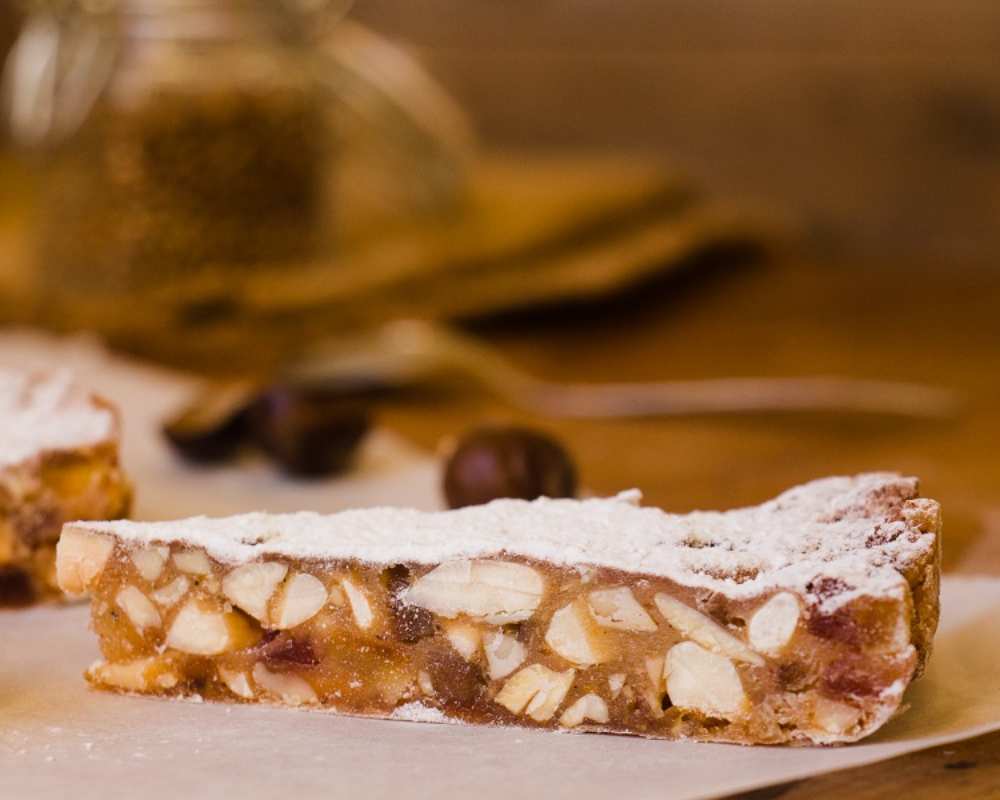Enjoy historic and tasty works of art
The city that rises on a hill surrounded by immense “buttresses in red and brown tones” (Henry James) is ready to welcome you with open arms. Here you can stroll through the winding streets, exploring the many Renaissance artworks in the city and sampling local sweets—the very specialties that made Siena famous in the gourmet world and characterize the perfumes and tastes.
Your itinerary begins at the Duomo. Here the most innovative artists of the 1400s conceived of their pictorial and sculpture cycles, including Bernardino di Betto, called Pinturicchio, who was commissioned to fresco the interior of the Piccolomini Library located inside the Cathedral. The library was created to house Pope Pius II’s collection and celebrate the splendor in an elegant yet exuberant format. The space under the frescos house a collection of antiphons decorated with some of the most amazing miniatures of the 15th century. The sculptures found inside are equally as illustrious and include works by Donatello, Vecchietta, Francesco di Giorgio and Michelangelo. The marble inlays in the floors represent another example of true Renaissance mastery, created by some of the 15th and 16th centuries greatest artists including Matteo di Giovanni, Guidoccio Cozzarelli, Benvenuto di Giovanni Antonio Federighi and, above all, Domenico Beccafumi, who designed 13 of them.
The Duomo, with its white marble and its spires, reminds us of one of Siena’s famous sweets—the Cavallucci biscuits covered with candied sugar and filled with almond paste. Their delicious smell permeates the historic center as bakers add the candied fruits or amaretto. Their origins are interesting: they were offered to visitors arriving on horseback as they were nutritious and easy to eat during a long journey in the saddle. Today, they are one of the town’s most treasured traditions.
Your itinerary begins at the Duomo. Here the most innovative artists of the 1400s conceived of their pictorial and sculpture cycles, including Bernardino di Betto, called Pinturicchio, who was commissioned to fresco the interior of the Piccolomini Library located inside the Cathedral. The library was created to house Pope Pius II’s collection and celebrate the splendor in an elegant yet exuberant format. The space under the frescos house a collection of antiphons decorated with some of the most amazing miniatures of the 15th century. The sculptures found inside are equally as illustrious and include works by Donatello, Vecchietta, Francesco di Giorgio and Michelangelo. The marble inlays in the floors represent another example of true Renaissance mastery, created by some of the 15th and 16th centuries greatest artists including Matteo di Giovanni, Guidoccio Cozzarelli, Benvenuto di Giovanni Antonio Federighi and, above all, Domenico Beccafumi, who designed 13 of them.
The Duomo, with its white marble and its spires, reminds us of one of Siena’s famous sweets—the Cavallucci biscuits covered with candied sugar and filled with almond paste. Their delicious smell permeates the historic center as bakers add the candied fruits or amaretto. Their origins are interesting: they were offered to visitors arriving on horseback as they were nutritious and easy to eat during a long journey in the saddle. Today, they are one of the town’s most treasured traditions.
Directly in front of the Duomo is the Spedale di Santa Maria della Scala, once a powerful economic institution. Its interior boasts a variety of masterpieces including frescos by Pellegrinaio; scenes from the Old and New Testaments by Vecchietta in the Upper Sacristy; and a Visitation by Beccafumi.
From here, head towards the Pinacoteca Nazionale, stopping on the way at a café or bakery asking to try the Ricciarelli — cookies shaped like large grains of rice. Their name honors their “patron” Ricciardetto della Gherardesca, veteran of the Crusades in the Holy Land, who inspired the decidedly Mediterranean flavor of the cookies made from almonds, eggs and sugar. A light lunch will reinvigorate you and prepare you for the afternoon.
Directly in front of the Duomo is the Spedale di Santa Maria della Scala, once a powerful economic institution. Its interior boasts a variety of masterpieces including frescos by Pellegrinaio; scenes from the Old and New Testaments by Vecchietta in the Upper Sacristy; and a Visitation by Beccafumi.
From here, head towards the Pinacoteca Nazionale, stopping on the way at a café or bakery asking to try the Ricciarelli — cookies shaped like large grains of rice. Their name honors their “patron” Ricciardetto della Gherardesca, veteran of the Crusades in the Holy Land, who inspired the decidedly Mediterranean flavor of the cookies made from almonds, eggs and sugar. A light lunch will reinvigorate you and prepare you for the afternoon.
Once inside the Pinactoteca Nazionale you will have entered a sort of encyclopedia of Sienese figurative culture, where all protagonists are amply illustrated with works of undisputed quality. See works by Francesco di Giorgio, Vecchietta, Matteo di Giovanni , Giacomo Cozzarelli, Benvenuto di Giovanni a, Girolamo di Benvenuto and Beccafumi.
At this point in your journey you will definitely be ready to taste the last—and perhaps the most famous—of all Sienese treats, Panforte. Made from candied fruit, honey, spices, dried fruit and sugar, it is a sort of homage to the abundance and warm perfumes of the east. Its colors remind us of pictures we saw in the Pinacoteca Nazionale. You can taste the explosion of tastes along with a glass of Vin Santo, the traditional “hospitality” wine of Tuscany. The colors of Panforte and the Vin Santo will pick up the colors of the setting sun bouncing off the red bricks of the buildings and you will experience all of Siena’s charm in one moment.
Once inside the Pinactoteca Nazionale you will have entered a sort of encyclopedia of Sienese figurative culture, where all protagonists are amply illustrated with works of undisputed quality. See works by Francesco di Giorgio, Vecchietta, Matteo di Giovanni , Giacomo Cozzarelli, Benvenuto di Giovanni a, Girolamo di Benvenuto and Beccafumi.
At this point in your journey you will definitely be ready to taste the last—and perhaps the most famous—of all Sienese treats, Panforte. Made from candied fruit, honey, spices, dried fruit and sugar, it is a sort of homage to the abundance and warm perfumes of the east. Its colors remind us of pictures we saw in the Pinacoteca Nazionale. You can taste the explosion of tastes along with a glass of Vin Santo, the traditional “hospitality” wine of Tuscany. The colors of Panforte and the Vin Santo will pick up the colors of the setting sun bouncing off the red bricks of the buildings and you will experience all of Siena’s charm in one moment.
For those who have more time and would like to visit more Renaissance masterpieces with a trip “outside the walls” (literally)—head to one of the most important religious monuments of the city dedicated to a Sienese nobleman, Pandolfo Petrucci, the Basilica dell’Osservanza. Founded by Saint Bernardino and chosen by Pandolfo as his burial place. The sacristy, designed by him, boasts a beautiful wood inlay choral box by Antonio Barili and a sculpture group in terracotta by Giacomo Cozzarelli.
For those who have more time and would like to visit more Renaissance masterpieces with a trip “outside the walls” (literally)—head to one of the most important religious monuments of the city dedicated to a Sienese nobleman, Pandolfo Petrucci, the Basilica dell’Osservanza. Founded by Saint Bernardino and chosen by Pandolfo as his burial place. The sacristy, designed by him, boasts a beautiful wood inlay choral box by Antonio Barili and a sculpture group in terracotta by Giacomo Cozzarelli.



